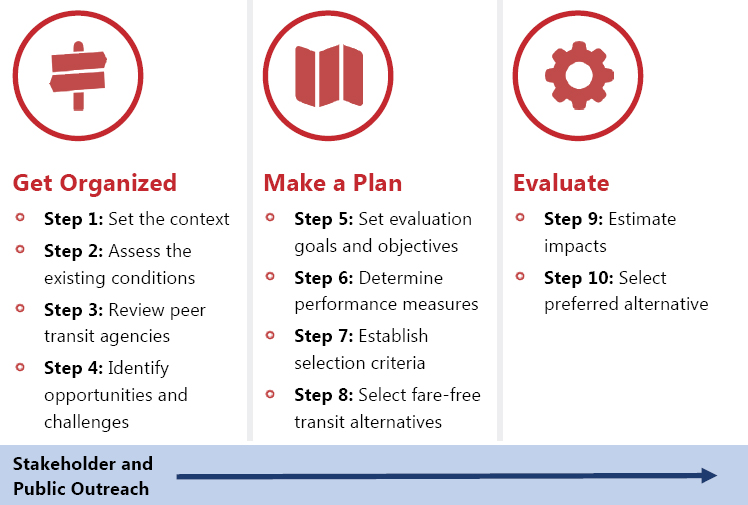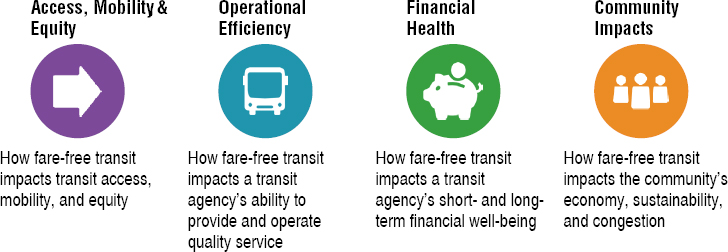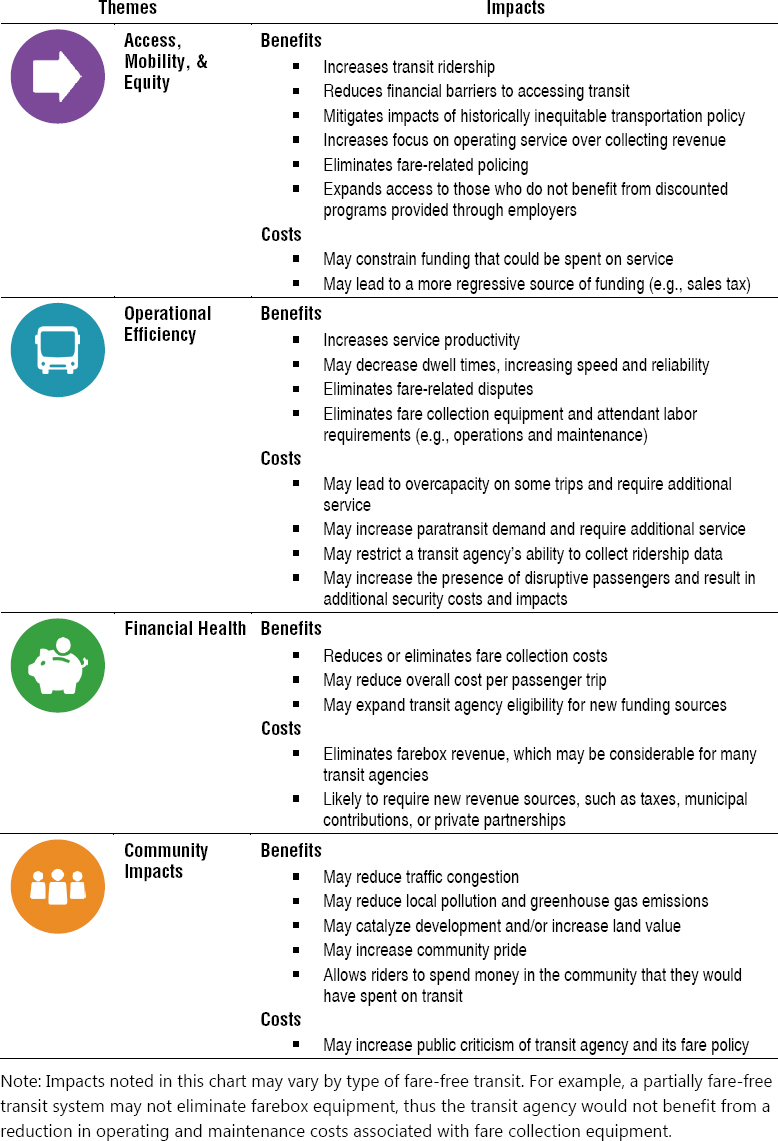
SUMMARY
Fare-Free Transit Evaluation Framework
Despite strong recent interest from transit agencies, there is no known research that presents a framework for transit practitioners to evaluate fare-free transit. This report presents a framework that can be used by transit practitioners to evaluate the potential benefits, costs, and trade-offs of implementing fare-free transit. The framework may also be used by community partners, including staff from related organizations, for instance, municipal departments, metropolitan planning organizations (MPOs), or neighboring transit agencies. This framework was informed by a transit agency survey and interviews with staff from transit agencies, community organizations, and transit advocacy groups.
The evaluation framework can help transit agencies get organized, make a plan, and evaluate fare-free transit (Exhibit S-1). By following the framework, practitioners can fully understand the potential costs, benefits, and trade-offs at their transit agencies. Along with the framework’s 10 steps, the research team shares examples from transit agencies that have evaluated fare-free transit in their community to show how the framework looks in practice, as well as identify opportunities to engage relevant stakeholders and the public.
Defining Fare-Free Transit
In this report, full and partial fare-free transit are defined as follows:
- Full fare-free transit: when a transit agency does not collect fares from any riders.
- Partial fare-free transit: when a transit agency does not collect fares from specific groups of riders, on certain routes or transit services, during certain times, or in defined areas.
Both full and partial fare-free transit can be implemented as policies or programs. A fare-free policy represents a decision made by a transit agency or governing body to not collect fares from some or all riders. A fare-free program is a planned set of actions undertaken by a transit agency to achieve transit agency or other local goals, such as a program to provide fare-free transit to riders with incomes below a defined threshold or a pilot program to test the impacts of fare-free transit. While fare-free transit exists on a spectrum of fare policies and programs that includes discounted fares, this report focuses solely on the evaluation of fare-free transit alternatives.
Fare-Free Transit Evaluation in Practice
To understand the current state of the practice of fare-free transit evaluation and inform the development of the evaluation framework for this report, the research team completed a transit agency survey and interviews with staff from transit agencies, community organizations, and transit advocacy groups. This research builds on the findings in TCRP Synthesis 101: Implementation and Outcomes of Fare-Free Transit Systems (Volinski 2012) and a literature and media

review of academic research, planning work, and journalism on fare-free transit. Through this review, the research team identified two main topics:
- Fare-free transit impacts: The measured and anticipated effects of fare-free transit for transit agencies and the communities they serve.
- Fare-free transit evaluations: How transit agencies have evaluated the impacts and long-term success of fare-free transit in their communities.
Fare-Free Transit Impacts
The research team identified four main themes in the fare-free transit impacts that transit agencies across the country are focused on: access, mobility, and equity; operational efficiency; financial health; and community impacts (Exhibit S-2).
Exhibit S-3 summarizes the measured and anticipated impacts of fare-free transit. More detail on each of these impacts can be found in Chapter 2.
Fare-Free Transit Evaluations
There are two primary time periods in which fare-free transit can be evaluated: before and after implementation. These two evaluation types can generally be described as follows:
- Feasibility Evaluation: Conducted before fare-free transit is implemented to see if it is feasible for a transit agency. This type of evaluation typically focuses on estimating the likely benefits and costs of one or more types of fare-free transit.
- Post-Implementation Evaluation: Conducted after fare-free transit has been implemented. This evaluation type usually analyzes how successful fare-free transit has been for the transit agency, including measured benefits and costs. Using this information, transit agencies may recommend continuing, modifying, or stopping the fare-free transit implementation.
The evaluation framework presented in this report focuses on the first type of evaluation: feasibility evaluation, as well as providing high-level guidance for what transit practitioners


should consider when implementing and evaluating fare-free transit. Chapter 3 provides a more detailed description of how both feasibility and post-implementation evaluations have been conducted by U.S. transit agencies, as well as a description of common elements included in both types of evaluations.
Transit Agency Case Studies
To inform the development of the evaluation framework and provide more detailed examples of how fare-free transit has been evaluated at transit agencies of different sizes across the United States, the research team developed 23 case studies, which are in Chapter 4 of this report. Transit agencies looking to evaluate fare-free transit in their community can identify similar systems and learn about their experiences. The case study transit agencies, agency type, and fare-free status can be seen in Exhibit S-4.





